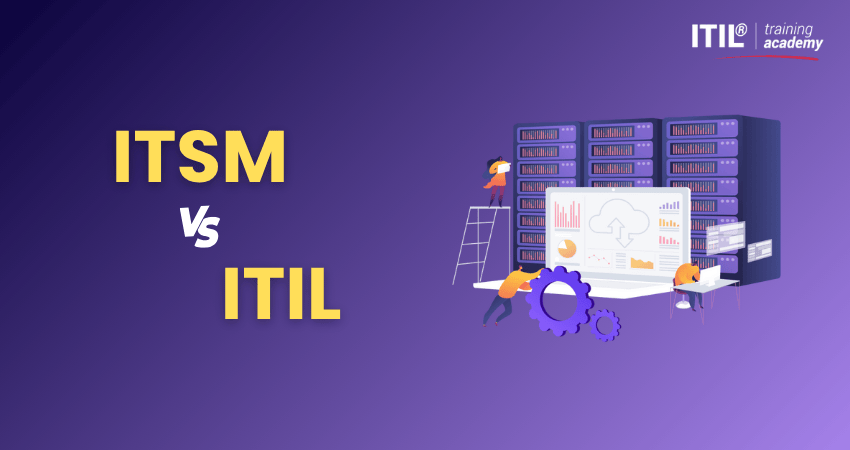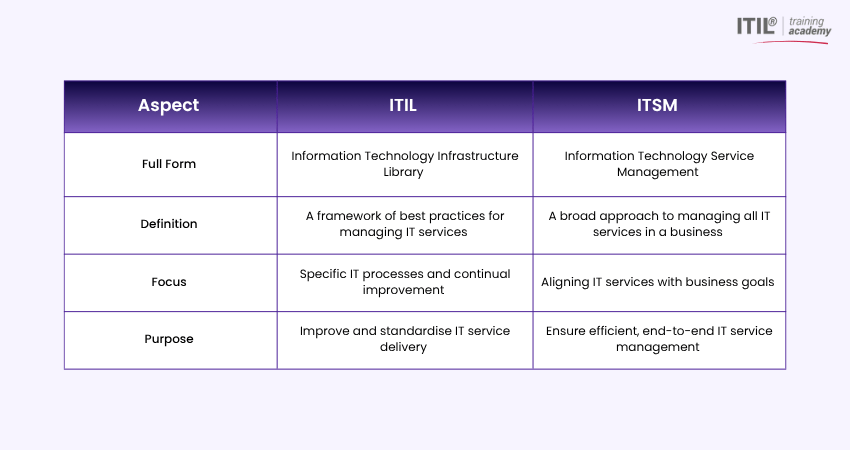
Author-David Walter
Last updated-Aug 8, 2025
Technology powers almost every part of a business, like the heartbeat that keeps everything alive. When IT systems work well, the whole company moves forward easily. But managing these complex systems takes more than just fixing problems; it needs a clear approach. This is where the difference between ITSM vs ITIL matters.
In this blog, we’ll explain what ITSM and ITIL are, how ITSM vs ITIL differ, and how they work together. You’ll also learn the benefits of each to improve IT support and business results. This blog is easy to understand for beginners and experts alike.
Table of Contents
1) What is ITSM?
2) What is ITIL?
3) ITSM vs ITIL: What's the Difference?
4) What are the Benefits of ITSM?
5) What are the Benefits of ITIL?
6) Conclusion
What is ITSM?
Information Technology Service Management (ITSM) is a strategic approach to designing, delivering, managing, and improving the way IT services are used within an organisation. It’s not just about fixing technical issues; it’s about making sure IT consistently supports business goals and delivers value.
ITSM covers the entire lifecycle of IT services, including:
a) Service design and planning
b) Implementation and delivery
c) Ongoing support and optimisation
By applying ITSM practices, IT teams can respond to incidents faster, support users more effectively, and maintain systems with greater efficiency.
What is ITIL?
Information Technology Infrastructure Library (ITIL) is the most widely adopted framework for ITSM. It provides a structured set of best practices to help organisations align IT services with business needs and ensure consistent, high-quality service delivery.
The latest version, ITIL 4, introduces modern methodologies such as:
a) Agile
b) DevOps
c) Lean
ITIL 4 emphasises flexibility and collaboration, guiding IT teams to treat the business as a customer and deliver services that meet user expectations. It is built around the Service Value System (SVS) and the Four Dimensions Model, which help organisations create value through effective service management.
Optimise your organisation's release processes. Join our ITIL® 4 Practitioner: Release Management Training now!
ITSM vs ITIL: What's the Difference?
Knowing the main differences in ITSM vs ITIL helps companies choose the best way to manage their IT services. It also helps them decide which rules or methods to use. Let’s look at this more closely.

1) ITSM vs ITIL: Core Components
ITSM means all the things a company does to take care of its IT services. It includes steps, tools, and jobs to fix problems and help people. ITSM uses guides like ITIL. For example, a company uses ITSM to manage all IT services like help desks, email systems, and networks to keep everything running smoothly.
ITIL is one guide inside ITSM. It gives rules and good ways to manage IT services. ITSM is big; ITIL is one part of it. For example, the IT team follows ITIL’s step-by-step guidelines to handle incidents and make changes safely and quickly.
2) ITSM vs ITIL: Uses
ITSM helps companies plan and run IT services every day. It helps fix problems and give good service. For example, when a computer stops working, ITSM ensures the problem is reported, tracked, and fixed by the IT team.
ITIL shows exact steps to follow in ITSM. It tells how to do the work right. ITSM says what to do, ITIL says how to do it. For example, ITIL provides the exact steps to investigate the computer issue and restore it without causing other problems.
3) ITSM vs ITIL: Primary Focus Areas
ITSM looks at the whole IT service and how it helps the business and users. It wants to make services good and useful. For example, ITSM focuses on delivering good service, like making sure all employees can access their email without trouble.
ITIL focuses on making IT work better by following rules and steps. ITSM wants good results; ITIL cares about how to get them. For example, ITIL focuses on improving the process of fixing email issues, so problems happen less often and are solved faster.
4) ITSM vs ITIL: Resource Allocation and Management
ITSM helps manage people and tools to keep IT services working well. It lets companies decide how to use their resources. For example, ITSM helps decide how many support staff are needed to answer user requests during busy hours.
ITIL gives clear rules about how to manage people and fix problems. It has set jobs and steps to follow. ITSM gives choices; ITIL gives rules. For example, ITIL clearly defines who is responsible for approving software updates and who handles problem management.
Elevate your IT career by mastering service level management. Join our ITIL® 4 Practitioner Service Level Management Training now!
What are the Benefits of ITSM?
ITSM helps companies keep their IT services working well. Here are some good things about ITSM:

1) Fix Problems Faster: ITSM enables IT teams to detect and resolve issues quickly, reducing downtime and improving productivity.
2) Better Service Quality: It ensures IT services meet user needs, making daily tasks easier for employees.
3) Clear Roles and Responsibilities: With structured processes, everyone knows their tasks, leading to faster, more coordinated work.
4) Cost Efficiency: ITSM helps organiations optimise resources, reduce waste, and avoid unnecessary expenses.
5) Improved User Satisfaction: Reliable IT services keep users happy and enable them to work without disruption.
6) Future-ready Planning: ITSM supports long-term IT improvement through structured evaluation and planning.
What are the Benefits of ITIL?
These are the benefits of ITIL:
1) Smarter Change Management: ITIL-certified professionals help implement structured, effective changes that boost performance and reduce risk.
2) Streamlined Tool Usage: ITIL knowledge makes it easier to adopt and use ITSM tools designed around ITIL principles.
3) Root Cause Resolution: ITIL promotes problem management practices that fix the underlying causes of issues, not just the symptoms.
4) Reduced Operational Costs: ITIL improves process efficiency, helping organisations save money through better resource use.
5) Stronger IT and Service Delivery: ITIL supports robust IT infrastructure, better customer service, and continual improvement.
6) Faster, Safer Adaptation: ITIL helps businesses make quick, secure changes to meet user needs while maintaining service stability and keeping detailed records.
Conclusion
Understanding ITSM vs ITIL helps companies choose the best way to manage IT services. ITSM is the big idea of managing IT, while ITIL gives clear steps to do it well. Using both can improve service, fix problems faster, and save money. Knowing the difference between ITSM and ITIL is important for any business that wants reliable and efficient IT services.
Elevate your IT Service Management expertise. Join our ITIL® Foundation Level Training now!
Most Recent
Date - Sep 20, 2025
Date - Sep 20, 2025
Date - Sep 20, 2025





 Back to
Topics
Back to
Topics

























